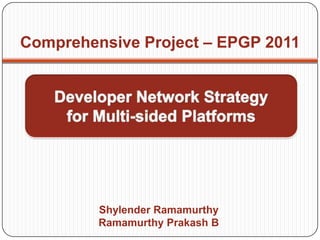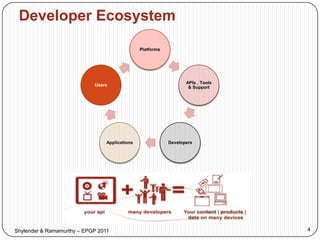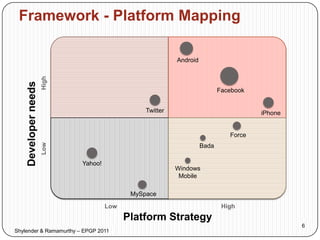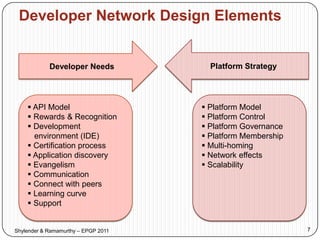Developer Ecosystems
- 1. Comprehensive Project â EPGP 2011Developer Network Strategy for Multi-sided PlatformsShylender RamamurthyRamamurthy Prakash B
- 2. Agenda Objective & Proposal
- 3. Developer Network Strategy Framework
- 4. Design Elements â Developer Needs
- 5. Design Elements â Platform Strategy
- 6. Platform Life cycle2Shylender & Ramamurthy â EPGP 2011
- 7. Objective Understand multi-sided platforms and Developer ecosystems Propose a strategy framework for building a successful developer ecosystemWhat we proposeMulti-sided platforms need to strike a balance between developer needs and platformâs strategy to create a thriving Developer ecosystem3Shylender & Ramamurthy â EPGP 2011
- 8. Developer Ecosystem4Shylender & Ramamurthy â EPGP 2011
- 9. Developer Network Strategy FrameworkPlatform diesPlatform thrivesDeveloper NeedsNo one adoptsDevelopers movePlatform Strategy5Shylender & Ramamurthy â EPGP 2011
- 10. Framework - Platform MappingDeveloper needsHighLowAndroidiPhoneMySpace BadaYahoo!FacebookTwitterForceWindows MobileHighLowPlatform Strategy6Shylender & Ramamurthy â EPGP 2011
- 11. Developer Network Design ElementsPlatform StrategyDeveloper Needs API Model
- 12. Rewards & Recognition
- 13. Development environment (IDE) Certification process
- 15. Evangelism
- 16. Communication
- 17. Connect with peers
- 18. Learning curve
- 19. Support
- 20. Platform Model
- 21. Platform Control
- 24. Multi-homing
- 25. Network effects
- 26. Scalability7Shylender & Ramamurthy â EPGP 2011
- 27. Developer Needs - Survey8Shylender & Ramamurthy â EPGP 2011
- 28. Design Elements â Developer NeedsAPI Model
- 29. Rewards & Recognition
- 30. Development environment (IDE)
- 31. Certification process
- 32. Application discovery
- 33. Evangelism
- 34. Communication
- 35. Connect with peers
- 36. Learning curve
- 37. Support9Shylender & Ramamurthy â EPGP 2011
- 38. Two sided Market and Platforms Two Sided Market
- 39. Network effects
- 40. Pricing
- 41. Chicken & Egg
- 42. Tipping
- 43. Envelopment
- 44. Multi HomingSide 1Side 2PlatformProvider10Shylender & Ramamurthy â EPGP 2011
- 45. Platform models11Shylender & Ramamurthy â EPGP 2011
- 46. Design Elements â Platform Strategy Platform Model
- 47. Platform Control
- 50. Multi-homing
- 51. Network effects
- 52. Scalability12Shylender & Ramamurthy â EPGP 2011
- 53. Platform life cycle13Shylender & Ramamurthy â EPGP 2011
- 54. Thank you14Shylender & Ramamurthy â EPGP 2011
Editor's Notes
- #14: API model exposed depends on the Platform model ( Integrator etc ) & control ( extend the platform or not ) as to whether more business functionality can be exposed or notApplication discovery ( market place ) might impact on how Platform governance is done and vice versaEasier Learning curve makes it more developers to adopt whereas at the same time Platform membership might inhibit developers joiningHigher R&R costs might require exclusivity which might move developers against multi homingEasier certification process can bring in more developers but that might also bring in negative direct network effects for Developers














